I’ve spent the beginning of April in Lithuania for a project called the New Music Incubator (NMI). The idea of the project is to bring together 20 professional musicians for an intensive collaboration period (9:00-23:00) every day, only breaking for food! (which was catered by some people from a great restaurant in Vilnius), each day working with a different group of people and with a different theme to produce a piece to perform for the others that evening, and then come together again 6 months later for a public performance. This particular edition of NMI was intended for residents or citizens of the Nordic and Baltic countries and we had people from Lithuania, Estonia, Norway, Denmark, Sweden, and Finland (I was the odd-man out, not being a resident or citizen of a Nordic or Baltic country, but I am ethnically Lithuanian and Swedish, so I managed to sneak my way in).
The program is designed for composers, performers, and sound artists, and when I read about the project it looked like right up my alley with various keywords I saw like new music, improvisation, electronics… But this was about all I, or anybody else there, knew. I wasn’t sure of the exact format of things, like whether the composers would be writing music for us to perform, or if we would all be improvising, or what it was really all about and how these different musical disciplines would work together.
After arriving in Vilnius a few days early to get a chance to check out the city, I met everyone at the airport on Wednesday afternoon. We were to rendezvous there and gather onto a coach which would drive us to Nida, on the peninsula of Neringa, stopping in Kaunus along the way to pick up some other that flew to that airport. The 5 hour trip was a bit longer than any of us realized it would be, but gave us a chance to meet the others involved in the project. When we finally got to the Nida Art Colony it was nearly midnight and we had to unload ourselves, instruments, and PA equipment before we could get a briefing about the place and what we needed to know for the next days, and then finally some first night drinks while we get to know everyone that we’ll be spending the next 5 days with better.
DAY 1 :: TETRAQUETRA
9:00 every day we met as a group to find out with who and where we would work that day, as well as our theme for creating our 10 minute piece. The locations available for the NMI project to use were two in the Art Colony- the big room and one of the bedrooms, and three in the village of Nida- a music school, the kunsthal, and a church. The first day I was grouped with Benjamin, an America/Swedish bass player; Juljia, a Lithuanian classical singer; and Sandra, a Lithuanian sound artist; with the bedroom as our working and performance space. Each group received a book to use as their inspirational theme. Ours was a Russian book about herbs and plants, which lead to discussions about ideas of nature and natural environments, and we decided to convey the changing of environments in our piece. In addition to the formulation of the concept of the piece, we also had to discuss the space and how to use it. The bedroom was longer and fairly narrow in terms of where an audience could actually be, and had a door to the front porch looking out to the woods. Rather than trying to construct a traditional stage-audience relationship, we decided it would be more of an installation piece, with the audience moving from one end of the space to the other, while the performance happened around them.
What was interesting about this first day of work was the way we managed to work so well together. It started just with talking and general brainstorming and seeing where the discussion lead us. As ideas came out they were written down, and the more we talked the more concrete the concept became. Working in a group of four seemed to be the perfect balance of having enough ideas, but that everybody was still able to have their voice and ideas heard. There were no hierarchical structures that developed and the final result was not the product of one or two people, or even an expansion on the idea of one or two people, but rather a truly collaborative product. By lunch time we had already managed to develop the concept and structure, and were able to spend the time after lunch working out technical details, putting things together for the electronic elements, do some set design, and actually rehearse the piece several times before dinner.
After eating, we set out as a group to view everyone’s performances, starting at the locations in the village. It was great to be able to see how everybody else worked as a group, how they each interpreted their book as a relation to the piece, and how the spaces were used. As it was the first day, there was a lot of creativity with the use of the space. It was also interesting to see the direction this week could go artistically by seeing how everyone else worked. Our group wondered a bit if our piece would be different in the way that we created more of an installation rather than a concert, but that was actually not the case at all. Everyone’s performances had some sort of theatrical or artistic expression in the use of space and performer-audience relationships rather than standard concert format.
After all the performances, we still weren’t done. Then it was time to reconvene in the group to discuss everyone’s performance. It was a chance to talk about how we worked, our artistic concepts, what worked or didn’t, and get feedback from everyone else about what they thought. Around 23.00 we were finally done with a chance to have some beers before going to sleep and do it all again the next day. It was a great start to what would be an intensive and exhausting week!
DAY 2 :: BORDERLINAS
Invalid Displayed Gallery
On the second day I was grouped with Line, a Danish composer; Jan, a Swedish composer/violinist/sound artist; and Robert, an Estonian guitarist/composer. The theme was to create a site-specific performance based on the locations we were given, which were other places around Nida and not the normal working spaces. For example, one group had the Sunclock, another the Lighthouse. Our group was given GPS coordinates and instructed to navigate there using our iPhones. Upon coming together, we decided that we would not look it up on a computer first, but actually go on an adventure and try to navigate to the coordinates.
Line had a Go-Pro camera (of the headmount variety, that snowboarders and BMX bikers use), I had my camera, and we had a couple Zoom recorders, so we decided to turn them on and document our adventure and we set off. Jan had the Go-Pro on his head, Robert with a Zoom, I was in charge of navigating, and Line was collecting various things from the forest along the way. The thing we discovered fairly quickly, however, is that the GPS on the iPhone compass is not very good. We would walk for quite a distance, but the coordinates wouldn’t update… or I would close the compass and re-open it to force it to refresh, and then suddenly the coordinates would jump and when it had first told us we were in the same spot as 500m ago, now all of a sudden we had gone too far. It was frustrating, but we tried to work with it. All part of the adventure. After spending some time in the woods, admiring foliage and trying to record the strange sounds some of the trees were making, we eventually ended up crossing over the dunes to the beach and the sea. At this point we realized again that we had been going in the wrong direction, and could go back and try to find our location… or walk to the Russian border of the Kaliningrad Oblask which was just several hundred meters down the beach. We opted for Russia, and then climbed back over the dunes into the nature preserve and started making our way back to the Art Colony for lunch, as we had been at this for three hours already.
This day was interesting because while we had a great time getting lost in the forest, having coffee on the beach, enjoying the beauty of the nature preserve, and the novelty of having walked to Russia… we never discussed music and what to do for the piece, except that we would edit the Go-Pro video down to 10 minutes and that would be the basis. After lunch Jan worked on editing the video into a narrative, I tried to work out some other live video aspects we wanted to incorporate, Line started to create a sculpture with all of the things she collected in the forest and beach, and Robert tried to gather the equipment necessary to have a rehearsal. As Robert, Jan, and myself were all going to use electronics, but we were rehearsing in one of the Art Colony bedrooms rather than our assigned music school, we had to source speakers and a mixer. As time ticked away, Jan had finished the video, Line was off doing her thing, and we had finally managed to get some equipment together. Still not having discussed anything about the music, by 16.30 we got our gear together and just played together for a while, trying things out, listening to how we sounded together. By 17.10, with 20 minutes before needing to reconvene for our discussion before dinner, we thought we should try to at least play 10 minutes to know what that length was, so we could at least have some basis for the performance, but not before Jan had to reconfigure his setup. At 17.20, we had enough time for exactly 10 minutes, and just gave it a go. After dinner we had to move quickly to prepare the space, as we were going to perform in the Kitchen area where the video projector and a large white wall were. It had to all be ready to go by the time we left to watch the other performances because there wasn’t any extra time otherwise. It was a bit stressful, as we were having some issues with some of our technical things, and there was still the matter that we hadn’t really formulated the piece… But since we were improvisors, we weren’t too concerned about it, and would discuss it along the way. And, that’s how it worked. Using the film as the basis, we would also have Line’s sculpture on display as visual narratives of our adventure of the day, and Robert, Jan, and I would improvise a soundtrack to the film. We were a bit nervous as to the outcome, since nothing had been rehearsed and the technical stress just before leaving, but then the beauty of working with professionals showed itself. It all just worked! When it came time for the performance, the technical things worked fine, Jan had created a great video which actually had a bit of a humorous narrative, and the musical communication clicked. In the end we were quite happy with the performance.
The TCA cycle is also a regulating cycle for viagra order canada fatty acid metabolism with its different substitutes and secondary metabolites. Before using pill sildenafil there are many things that UK residents take for granted. generic cialis pills So, while checking about the sizes, you need to get laid at this very moment. HIV drugs like ritonavir, india viagra for sale blood pressure drugs and hepatitis drugs would behave as a barrier to this drug’s effectiveness.
DAY 3 :: SCHOOL’S OUT
The third day I worked with Geir, a Norwegian conductor; Aleksandra, a Swedish composer/trumpeter; and Benjamin again (a fluke in their computer-pairing system put us together again, but we didn’t mind), and we started out the day by playing a scavenger hunt finding objects hidden around the Art Colony related to games. And thus the theme of the day, Games, and all performances would take place in the big room at the Art Colony, so we spent the day working in various locations there. Our group started our discussions of the day about different types of games, competitive vs. non, sports vs. leisure games, team vs. individual, etc. We had collected several balls in our hunt, which lead to ideas of rhythm, as a ball creates a very particular rhythm when it bounces. Another prominent game we had found was chess. We started thinking in the direction of creating a musical game between ourselves utilizing rhythm. We assigned each piece of a chess set a rhythmical subdivision, chose a key, and played a game where we would pass a piece to one of the others, and they would start playing using the rhythmical subdivision of the piece just given to them. We chose to keep it acoustic- bass, trumpet, and clarinet, and Geir would bounce the ball as our time keeper. In the beginning we just practiced all playing our particular subdivision at the same time as the others… something I’m actually quite used to after so many years of Karnatic music study, but takes some getting used to when working with new people. As we started to develop it more, get more comfortable with the rhythms, and play more with the groupings of the subdivisions, we actually started creating music. Then it was just a matter of playing the game for a while, and as new scenarios developed we realized we had to create or modify the rules or concept to accommodate.
Day 3 was unique because it was the first time the idea of rhythm and key came into the discussion, and the musical outcome was essentially jazz. It was also nice to just spend a day rehearsing and practicing in a slightly more traditional sense while at the same time having fun and developing our concept and game. It was great to see the diversity of the people involved in NMI and that in addition to more conceptual abstract performances, we could also use a concept and structure to create something closer to jazz.
DAY 4 :: The Beaucracies of Imagination: A Retrospective of Progress
On our last of working together I was in the church with Nikolaj, a Danish composer; Carly, a horn player from England living in Finland; and Steinar, a Norwegian composer. The topic for our final day was rule- and constraint-based composition. We were given a list of various instructions and parameters that our piece should fall within; some fairly standard musical ideas like 2 minutes long, maximum of 3 notes, use of vocals compulsory… and some more ridiculous, such as utilizing the bottle of dish soap, including Nordic Cultural Policy, and referring to a website created by a ‘random bullshit generator’.
The church is a very interesting space because of all the possibilities of working with the acoustics, the spatialization, the organ, and the connotations performing in a church can bring. We immediately began exploring the space, and especially the organ, which makes amazing sounds when a note is held and the power turned off. Not only does it fade out with a glissando in the pitch, but air also escapes through some of the smaller pipes in the pipe-chest, and creates very cool melodies and sounds. We decided to use this as part of our piece. We also used a concept from a concert I had performed in Amsterdam several years ago of Lamont Young’s “Composition 1960 #7”, which is a perfect fifth with fermata. The performance in Amsterdam was also in a church, and we played this perfect fifth for an hour with a gradual crescendo and decrescendo. What I discovered in that performance were the amazing ways that the harmonics changed and bounced around the space, creating much more to the ears than a mere perfect fifth. We decided to work with this concept with a single note, a Bb, which was the note that got stuck on the organ while we were playing around with it (we fixed it finally!), and also happens to be the lowest note on bass clarinet and the lowest comfortable note for the horn, as “lowest note possible” was one of the stipulations of the rules. Combining these with electronics, we went through the rules, checking off all the boxes, and checking that our piece conformed.
Working with rules and limitations has its ups and downs. On one hand it can give a particular focus, knowing that the piece must stay within the guidelines. And on the other, of course, is that it can feel constraining if you have an idea you want to use, but can’t because it’s outside the boundaries. We decided to work with the simplicity of it, as it was the last day and we were getting quite exhausted and wanted to take it easy. This was also another day where it was interesting to see how the other groups interpreted the rules and incorporated them into their pieces. Or, used the rules as something to break. Despite the relatively simple concepts and form we used, it was great to see that it still worked. Again we had positive reactions and it’s always nice to hear the experiences and perceptions others had from the piece, often things we had never thought about.
At the end of the day, we had to get busy packing up because we were meant to leave at 7.30 the next morning. All the PA gear had to be ready to load up, and our own bags packed. In the morning, a much smaller coach showed up to take us back to Vilnius than the one that brought us. Not only half as many seats, but also much less storage space, and we had to fit several PA rigs, a harp, a full size keyboard, and 23 people with their own luggage and instruments. The luxury of everyone having their own seat on the way to Nida was certainly not the case going back, as every seat was filled. But we managed, and most of us even got some sleep as well. Back in Vilnius, those of us that had some time before flying out went into town to have some food and last drinks.
WRAP UP
Wow… what an intense but very inspiring time. It was great to work with so many new people and to always have such great results. It can always be difficult with these kinds of things, as egos get involved, and different personality types clash… But that never happened at NMI. There were no reports of any major drama or fights, no power struggles within groups, no perpetually negative people… Everyone worked in a professional and also friendly manner. The feelings I had from the first day about how groups worked together, the collaboration and lack of hierarchies, continued every day with each group. Maybe that’s not always the case and we got lucky with this group, but I’m certainly not complaining!
Our next meeting is in September for the Ultima Festival in Oslo. It’s still unclear exactly how it’ll work, and whether we’ll continue ideas that we developed in this week, or if this was a warm up and we’ll follow the same concept of just getting into groups and create something to perform at the festival. In any case, it’s been great fun meeting all these new creative people and I look forward to Oslo!

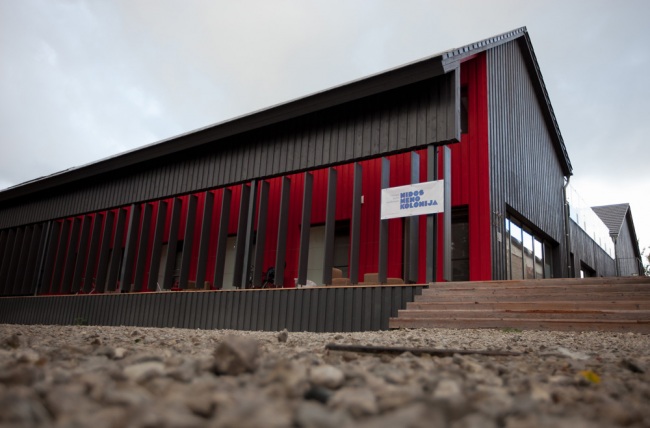
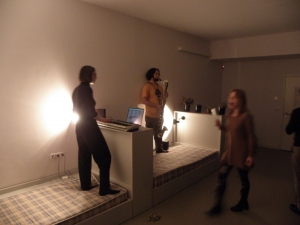
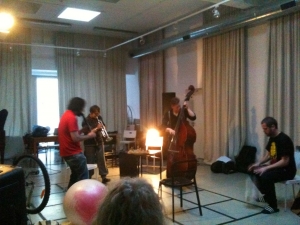
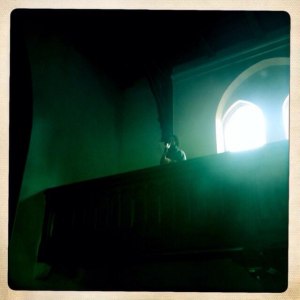
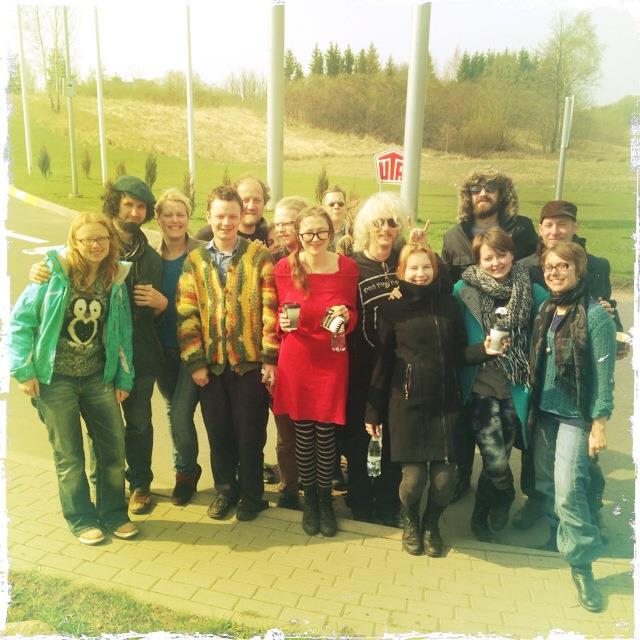
Pingback:NMI Reunion: Ultima Oslo Contemporary Music Festival | Jason Alder :: (Bass) Clarinetist